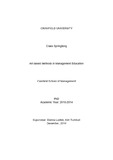JavaScript is disabled for your browser. Some features of this site may not work without it.
| dc.contributor.advisor | Ladkin, Donna | |
| dc.contributor.advisor | Turnbull James, Kim | |
| dc.contributor.author | Springborg, Claus | |
| dc.date.accessioned | 2015-05-29T15:38:12Z | |
| dc.date.available | 2015-05-29T15:38:12Z | |
| dc.date.issued | 2014-12 | |
| dc.identifier.uri | http://dspace.lib.cranfield.ac.uk/handle/1826/9212 | |
| dc.description.abstract | The purpose of this dissertation is to develop explanatory theory for the learning processes facilitated by art-‐based methods in management education (ABMs). Such theory is important because managerial educators increasingly use ABMs, and without a well-‐developed theory it may be difficult to realise these methods’ full potential. Current research on ABMs uses theories from other fields but generally sees ABMs as methods for making important information available for reflection, e.g. information about unconscious assumptions, aesthetic experience, or non-‐propositional or tacit knowledge. This shows that the field is grounded in a representationalist view of cognition. This view of cognition makes it difficult to explain certain themes in the research field, such as, the importance of staying with the senses without reflecting, aesthetic agency, and the process of making. I therefore asked: What insights can be gained from exploring ABMs, using theories grounded in the embodied view of cognition, in particular Conceptual Metaphor Theory (CMT) (Lakoff & Johnson, 1999) and simulation theories (Barsalou, 2008). For the empirical work, I used an experimental design with 60 managers from Danish companies. All participants selected problems from their work they perceived as important, yet unsolvable. They were randomly divided into three groups: Two groups using different ABMs to address problems and a comparison group where no ABM was used. The experiment indicated that 1) creating new metaphors for a problem based on different sensory metaphors enabled the participants to import behaviour from contexts unrelated to the problematic situation, and 2) focusing on sensory experience enabled participants to remove judgments about self or others. Furthermore, the experiment indicated that learning outcomes reflected participants’ experience of the concrete learning intervention. These findings contribute to CMT by suggesting that it is possible to formulate relationships between changes in metaphors and specific learning outcomes. They contribute to ABM by suggesting that experiences that participants have during ABMs are later used as tools for structuring other experiences – not merely as data for reflection. | en_UK |
| dc.description.sponsorship | ESRC (Economic and Social Research Council) | en_UK |
| dc.language.iso | en | en_UK |
| dc.publisher | Cranfield University | en_UK |
| dc.rights | © Cranfield University 2014. All rights reserved. No part of this publication may be reproduced without the written permission of the copyright owner | en_UK |
| dc.title | Art-based Methods in Management Education | en_UK |
| dc.type | Thesis or dissertation | en_UK |
| dc.type.qualificationlevel | Doctoral | en_UK |
| dc.type.qualificationname | PhD | en_UK |
| dc.identifier.grantnumber | ES/19005271 | en_UK |
